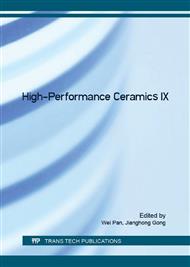p.617
p.623
p.629
p.633
p.639
p.644
p.648
p.652
p.658
Mechanical Properties and Microstructure of 2.5D Cf/ZrO2 Composites Prepared by Precursor Infiltration and Pyrolysis
Abstract:
The 2.5D Cf/ZrO2 composites were fabricated by precursor infiltration and pyrolysis (PIP) with ZrO2 precursor slurry as an impregnation liquid and 2.5D carbon preform as a framework. The effect of cycles of infiltration-pyrolysis on mechanical properties and microstructure of composites was investigated. The results showed that with the increase of cycles of infiltration-pyrolysis the flexural strength and relative density of as-prepared 2.5D Cf/ZrO2 composites increased. After 15 cycles of infiltration-pyrolysis, the density and flexural strength of as-prepared composites were 2.53±0.04g/cm3 and 73.2±2.2MPa respectively. In addition, the specimens with higher densification can transfer load efficiently between ZrO2 and carbon fiber, result in good mechanical properties of composites.
Info:
Periodical:
Pages:
639-643
Citation:
Online since:
July 2016
Authors:
Keywords:
Price:
Сopyright:
© 2016 Trans Tech Publications Ltd. All Rights Reserved
Share:
Citation:


